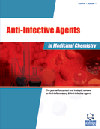- Home
- A-Z Publications
- Anti-Infective Agents in Medicinal Chemistry (Formerly Current Medicinal Chemistry - Anti-Infective Agents)
- Previous Issues
- Volume 6, Issue 4, 2007
Anti-Infective Agents in Medicinal Chemistry (Formerly Current Medicinal Chemistry - Anti-Infective Agents) - Volume 6, Issue 4, 2007
Volume 6, Issue 4, 2007
-
-
Two Different Functions of Doxycycline Which is Both An Antimicrobial Agent and An Immune Modulator
More LessAuthors: Masaki Fujita and Yoichi NakanishiDoxycycline is a semi-synthetic tetracycline, which was invented and clinically developed in the early 1960s. Doxycycline works by inhibiting protein synthesis and it is also bacteriostatic. Doxycycline is highly effective against all of the common pathogens that cause upper respiratory tract infections. Doxycycline is particularLY effective for the treatment of atypical pneumonia due to Mycoplasma, Chlamydia and Legionella. Read More
-
-
-
New Developments in Therapeutic Agents for Legionnaires' Disease
More LessAuthors: Jorge Roig, Josep M. Arnau, Antoni Vallano and Jordi RelloLegionella spp have been identified in many series as responsible for a variable percentage of communityacquired pneumonia (CAP) and for some outbreaks of hospital-acquired pneumonia (HAP). In many geographic areas Legionella ranks second to pneumococcus on the list of causes of severe CAP (SCAP). Therapeutic approach remains an important goal since the case-fatality rate is 5% to 30%, with elderly and immuno Read More
-
-
-
Antibacterial Agents Against Methicillin-Resistant Staphylococcus aureus (MRSA) and Vancomycin-Resistant Enterococci (VRE)
More LessThe emergence of nosocomial infections caused by methicillin-resistant Staphylococcus aureus (MRSA) and vancomycin-resistant Enterococci (VRE) has prompted research directed at the development of novel antibacterial agents to treat these diseases. This review will examine the literature on anti-MRSA and anti-VRE antibacterial research published between 2001 and October 2006.
-
-
-
Inhibition of Membrane Fusion as a Target for Antiviral Therapy
More LessAuthors: Richard K. Plemper and Anthea L. HammondEntry of enveloped viruses into cells is initiated by virus binding to a target cell receptor. Subsequent conformational changes in the viral envelope proteins are triggered either by receptor binding or by the low pH of the endosome, depending on the virus family, and facilitate fusion, or merging of the viral and host cell membranes. This allows transfer of the viral genome into the target cell, initiating a new infectious cycle. Inhibit Read More
-
-
-
Antiidiotype-Derived Killer Peptides As New Potential Tools to Combat HIV-1 and AIDS-Related Opportunistic Pathogens
More LessAuthors: W. Magliani, S. Conti, D. L. Maffei, L. Ravanetti and L. PolonelliThis review describes the novel experimental observations on antimicrobial and antiviral activities of a synthetic killer peptide (KP), derived from the variable region of a recombinant antiidiotypic antibody mimicking a widespectrum microbicidal yeast killer toxin (KT). The rationale, generation and experimental use of KT-like antiidiotypic microbicidal antibodies and mimotopes against the opportunistic pathogen Candida albican Read More
-
-
-
Structure-Function Relationship of Thiazolides, a Novel Class of Anti-Parasitic Drugs, Investigated in Intracellular and Extracellular Protozoan Parasites and Larval-Stage Cestodes
More LessAuthors: Andrew Hemphill, Norbert Muller and Joachim MullerThe thiazolide nitazoxanide (2-acetolyloxy-N-(5-nitro 2-thiazolyl) benzamide; NTZ) is a compound that has been synthesized based on the structures of niclosamide (antihelminthic) and metronidazole (anti-anaerobic). It is essentially composed of a nitrothiazole-ring and a salicylic acid moiety, which are linked together through an amide bond. NTZ exhibits a broad spectrum of activities against a wide range of intestinal and tiss Read More
-
Most Read This Month
Article
content/journals/aiamc
Journal
10
5
false
en


